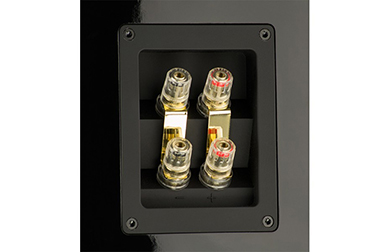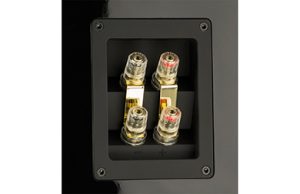
Bi-wiring and bi-amping: what’s the fuss?
 Some speakers like the ELAC Adante’s or the new ELAC Vela’s, the Klipshorns and the RF7 III, the SVS Ultra’s, the Dali Epicons and the Q Acoustics Concept 500’s come with two pairs of terminals (binding posts) at the back of the speaker. They allow for bi-wiring or bi-amping. Huh?!
Some speakers like the ELAC Adante’s or the new ELAC Vela’s, the Klipshorns and the RF7 III, the SVS Ultra’s, the Dali Epicons and the Q Acoustics Concept 500’s come with two pairs of terminals (binding posts) at the back of the speaker. They allow for bi-wiring or bi-amping. Huh?!
Mainly it’s a right reserved for high end speakers, but some very affordable speakers like the Emotiva Airmotiv’s T1 floorstanders offer the option too. The topic of bi-wiring and bi-amping is the cause of many heated discussion on audiophile forum. Even people who know a thing a two about AV don’t always agree on their merits.
Time for us to give you our 5 cents worth of insight.
But before we dissect what bi-wiring and bi-amping means, we should consider a few things.
Speakers analysed
Typically a (bookshelf) speaker has two drivers, commonly called “Tweeters” and “Woofers”. As you no doubt are aware, these two different drivers are designed to carry different frequencies of the sound’s signal. Tweeters are responsible for reproducing the signal’s higher frequencies. Woofers are responsible for the lows, or mids and lows.
This divide-and-conquer method of sound reproduction actually provides several advantages to the more straight-forward “send-the-whole-dang-signal-through-one-speaker driver”. Mainly:
1. It’s a significantly more efficient use of power
2. It provides a more accurate reproduction of the original sound in its designated frequency.
Don’t worry. We won’t keep it laughably easy…
Bi-wiring
So, the “Bi-wiring” idea is to take your basic loudspeaker with its two drivers (the tweeter and the woofer) and hook it up to a power amp in such a way as to “optimize signal flow”
This means: instead of running the one cable pair from the amplifier to the speaker, you run 2 separate lengths of cable to your speaker. One pair for the high frequencies (tweeters) and one pair for the low frequencies (woofers). On the amplifier-side however, both those cables are combined into one pair of terminals at the amplifier.
The claim is that by adding extra cables in the circuit and keeping them separated into high-frequency and low-frequency sections, it “frees up” the cables in order to focus particular frequencies into a particular path.
While the idea of bi-wiring sounds fancy, the question is: what difference does it make?
The short answer is ‘not much’. While you may be able to measure a slight difference, your ear won’t be able to tell. Audioholics did a whole calculation on the changes in impedance when bi-wiring. While their entire maths exercise shows a slight difference, it’s so small that it’s not likely to be significant.
Here’s why:
1. at the amplifier end, we are still dealing with a single source of amplification that comes into play before the signal is split.
2. instead of adding cables in order to lessen resistance, you could just simply get larger guage wires to handle more load.
So, our advice: save your money and use a cable with the appropriate gauge instead. That said, outside the unnecessary cost of bi-wiring, there is no harm in doing it either.
And then there is bi-amping…
Bi-amping
People often mention bi-wiring and bi-amping in one breath, but bi-amping is a little bit more complicated than bi-wiring. We try to keep it simple.
Bi-amping means that you use two power sources (amplifier channels) for each driver, one for the highs (tweeters) and one for the lows (woofers).
It does mean that somehow you have to split the signal and sort the frequencies into the correct amp. And that of course is the job of the crossover.
In terms of the binding posts at the back of your speaker (which we discussed earlier) it means that each of the binding posts will be connected to a different amplifier channel.
There’s a few ways to do bi-amp and it’s probably good to have a look at what the benefits are of each option: there’s active vs passive, and horizontal vs vertical.
Passive Bi-amping
So back to those crossovers.
A passive crossover splits the frequency after amplification inside the speaker. Passive crossovers are considered less efficient than active crossovers (more about those further). This is because power is wasted while filtering the amplified frequencies and the excess is burned as heat. What a waste!
So, in passive bi-amping, two separate amplifiers channels are used to drive the high and the low frequencies. But it is still the passive crossovers that are built in the speakers that are policing the high, mid and low frequency reproduction.
Whether there is any point in passive bi-amping is the cause many discussion in audiophile world. It’s called ‘fools bi-amping’ by some, which I guess says a lot about the intensity of the discussion.
That said, some reputable audiophiles will argue that there is some advantage to be achieved in passive bi-amping.
They argue that splitting the high and low frequencies does have some effect. This is because the amplifiers each now see a different load than one would under normal circumstances when individually driving the entire speaker. The result is still less demand of power from the amplifier.
One could argue that the same result could also be achieved by simply using a more powerful amplifier
Active Bi-amping
Active bi-amping is considered the ‘real deal’ and definitely not for the faint hearted. But when done well, it can make a big improvement to a system.
Active Bi-amping refers to the use of an active crossover. It splits the electrical signal into high and low frequencies before it reaches the amplifiers. This of course saves a lot of power that otherwise would just be burned off as heat
The result is more flexible configuration, reduced distortion, and more efficient allocation of power resulting in a greater sense of clarity and dynamic ease
The downside: the most obvious one would be extra cost (Two amplifiers, an outboard crossover and extra speaker wire are required)
On top of that system complexity is greatly increased. The passive crossover needs to match the characteristics of the speaker system (customisation, anybody?). You really need to know your way around test equipment for proper set-up.
For most of us, a power amplifier with double the power is a much cheaper and simpler way of dealing with things.
But we haven’t cover all bi-amping ground yet.
Horizontal vs Vertical Bi-amping
Horizontal and vertical bi-amping are further subsets which can be applied to both active and passive bi-amping, and imply the use of multichannel amplifiers.
In a horizontal arrangement, one amplifier is used to drive the high frequency elements of multiple loudspeakers, while another amplifier is used to drive the low frequency elements. The benefit here is that you can pick amplifiers which you feel are best suited to their given task, i.e. you wanted to use a tube amplifier for the mids and highs, but a big solid state amp to drive the low end.
A vertical arrangement switches things such that two channels from a single amplifier are used to drive both the high and low frequency elements of a single speaker. This can better balance resources, and keep one amplifier from getting overloaded with low frequency material while the other sails along reproducing the much less abundant high frequency content.
Note: It’s important to utilise amplifiers with similar gain structures to ensure level matching between the low and high frequency sections of the speaker system. This is important for proper integration.
The bottomline
So what’s the verdict on bi-wiring and bi-amping? Is it audibly better than a single cable or single amp connection?
As we previously discussed bi-wiring audible benefits are usually negligible. But then again; there is no harm in trying either. All you need is some extra speaker cable. Just make sure the cable used is all identical.
Bi-amping can offer an improvement in sonics, and dynamics depending on the equipment and implementation. Active bi-amping however is not recommended because of the specialised equipement needed (an outboard crossover) and the outrages level of skill required. I mean you have to outperform the crossover designed by the engineers that built the speakers for starters. Bart is an engineer by training and deals with AV on a daily basis but he won’t even consider going there. Just saying. 🙂 That said, when done well, active bi-amping can potentially make a big difference.
As with anything, it basically comes down to your preference and in this case also your set of skills.